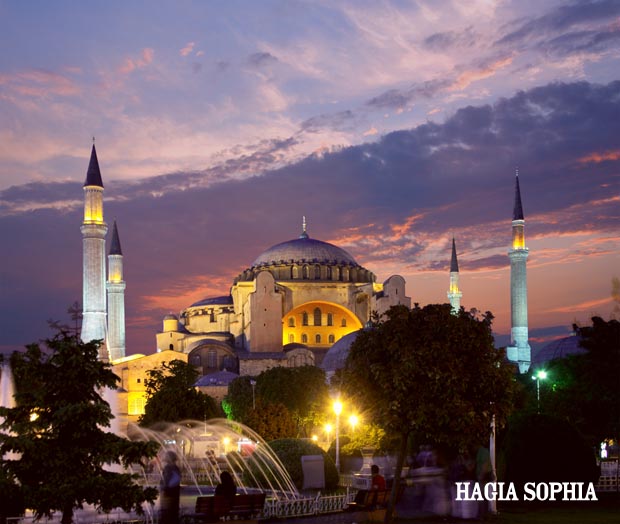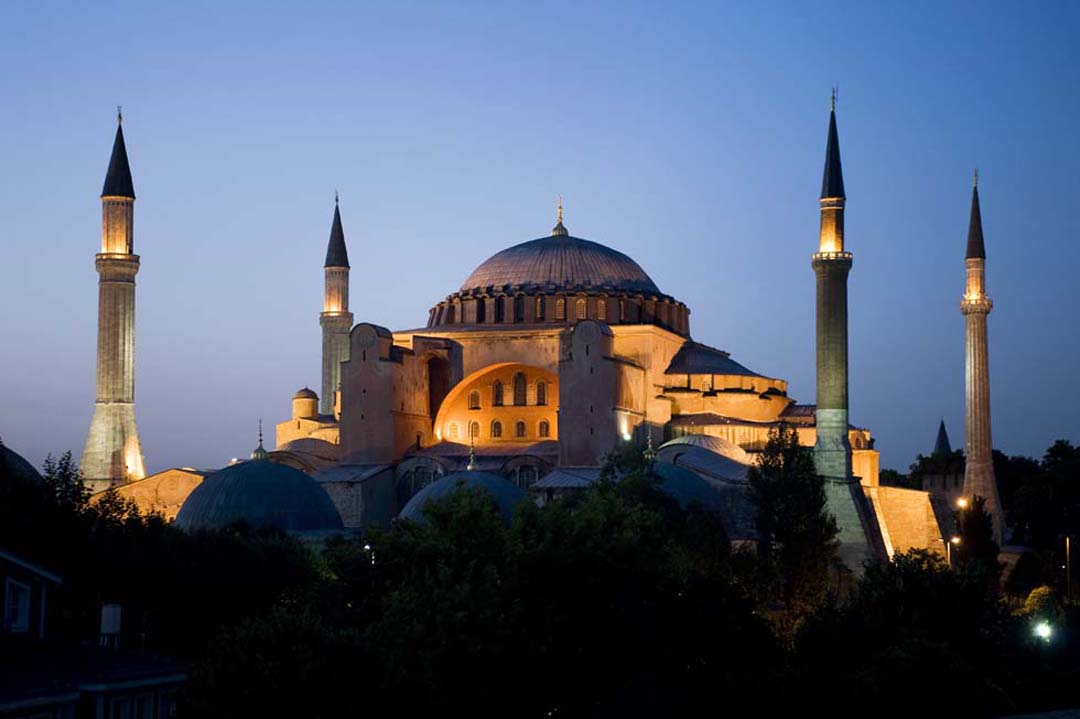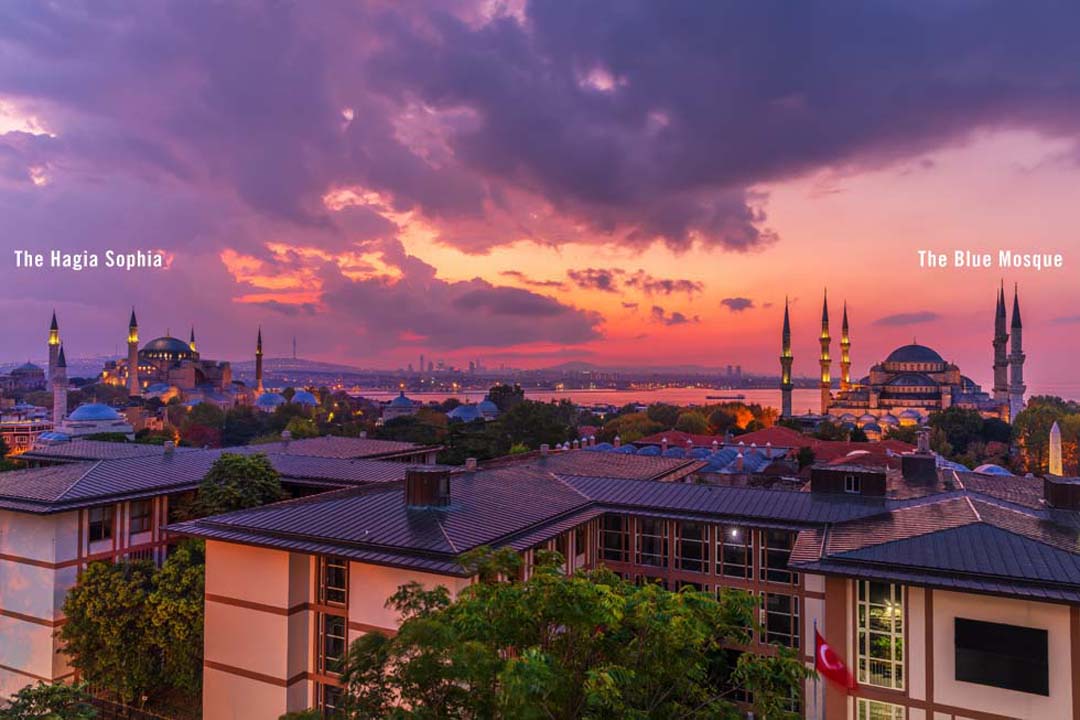Hagia Sophia
Greek: Ἁγία Σοφία
Latin: Sancta Sophia
![]() Origin of the Byzantine Hagia Sophia
Origin of the Byzantine Hagia Sophia
![]() The Hagia Sophia as a Catholic Cathedral
The Hagia Sophia as a Catholic Cathedral
![]() The Hagia Sophia history as a mosque
The Hagia Sophia history as a mosque
![]() Kemal Ataturk and the Hagia Sophia
Kemal Ataturk and the Hagia Sophia
![]() The Hagia Sophia as a 21st century mosque
The Hagia Sophia as a 21st century mosque
![]() Description of the original Hagia Sophia of Justinian I
Description of the original Hagia Sophia of Justinian I
ADVERTISEMENT
Guide Book for the Peloponnese: with Athens, Delphi and Kythira – Paperback – Amazon – Bradt Travel Guides, 288 Pages, November 18, 2025
Origin of the Byzantine Hagia Sophia
The Hagia Sophia was constructed by Justinian I (Justinian the Great, Eastern Roman Byzantium emperor from 527 to 565. Justinian lived 482 AD - 565 AD) on the ruins of the Basilica of the Church of St. Sophia which was wrecked during the "Nika" revolt of 532. Justinian ordered huge amounts of marble, plus precious stones, ivory, gold and silver to be utilized for the much grander reconstruction of the church, assigning the architectural work to Anthemius (from Tralles) and Isadore (from Miletus). Justinian provided over ten thousand workmen, and the expansion and finished construction was basically completed in five years, being dedicated on Christmas Day in 537 AD.
Description of the original Hagia Sophia of Justinian I from the book History of the Byzantine Empire by George Ostrogorsky
The Hagia Sophia as a Catholic Cathedral
Between 1204 and 1261, the building was converted into a Catholic church due to the occupation by the Fourth Crusade, sent by Pope Innocent III to recapture Jerusalem, then under control of the Saladin Ayyubid dynasty, but the Crusaders (a smaller portion of the crusaders refused to participate and left the main army) instead sacked Constantinople, this caused the Byzantine Empire to split into three states of Nicaea, Trebizond and Epirus. In 1261 it was from Nicaea that a Byzantium force retook the city and re-established Byzantium.
The Hagia Sophia history as a mosque
Following the conquest of Constantinople by the Turk army under Sultan Mehmet II (aka Mehmed the Conqueror) in May 29, 1453, the structure was soon made into a mosque, and the remaining Byzantine church leadership moved to the Church of the Holy Apostles, a small distance to the northwest away on the same side of the Golden Horn. (This church, in poor condition, was demolished a few years later and the Fatih Camir mosque built in its place). The converted Hagia Sophia served as the main mosque in Constantinople/Istanbul until 1616 when the Blue Mosque (aka Sultan Ahmed Imperial Mosque), a short distance to the south, was built. The two structures are close by each other and the Blue Mosque is designed in the same Byzantium style.
Kemal Ataturk and the Hagia Sophia
In 1934, President of Turkey Mustafa Kemal Ataturk shifted the Hagia Sophia into a museum with a single overnight order, but the process leading up to that was a benign step-by-step interlude in which foreign scholars were given permission to study the structure (while it was still a mosque). In 1928, the building was closed to the public. The historical work being done with foreign scholars contributed to an effort over decades that revealed from behind plastering the icons and other artefacts and decorations which had been hidden when the structure had been taken under the control of Mahmed the Conqueror following the defeat of Constantinople in 1453.
Historical accounts combine a number of issues together to provide a basis for Ataturk's decision, so there is not one single explanation for Ataturk's decision about the Hagia Sophia, but several. One reason usually given is that it was a gesture of friendliness toward the other signers of the Balkens Pact of 1934 (Greece, Turkey, Romania and Yugoslavia, aligned together against Bulgaria in February 1934 because Bulgaria had made claims on territories in Greece and Turkey); another explanation is that the transfer of the structure to be controlled by Turkey's museum authority was a signal to the West, especially the Americans, that Turkey was a modernizing country and that it viewed the Hagia Sophia as place that a person from any land, religion or class should be allowed to visit (this phrasing is attributed to Ataturk himself in the "verbal order" that he gave that started the process of converting Hagia Sophia into a museum).
Ataturk's decision came with such rapidity and surprise that there was no time for comment by the Turkish media of 1934 nor were other leaders consulted, it was, because of Ataturk's power as President, a fait accompli.
The Hagia Sophia as a 21st century mosque
Since 2013 the minarets at the four corners of the Hagia Sophia have been used again for the muezzin call to prayer, and a small room on the premises is officially set aside as a prayer room for Moslem or Christians alike, but organized Moslem prayers within the building have been ongoing since 2016.
[Updated July 2020) The structure is/was a part of the UNESCO system for preservation of historical buildings, and is/was also under the authority of Turkey's Museum system, and there were other legal issues involved with Turkey's Council of State, but on July 24 these issues appear to have all been solved within Turkey's court system, so technically these organizations are no longer within any right to interfere in the transition of the building again into a mosque.
Hagia Sophia News
Complaints about the ongoing damage to the Hagia Sophia
December 5, 2022: Story at Ethnos [Greek]
June 4, 2021: US Lawmakers urge push back against Erdogan over Hagia Sophia violations
Story at Skai [Greek]
Jan 1, 2021: Erdogan starts off 2021 at Hagia Sophia
Story at Eleftherostypos [Greek]
Erdogan's moves on Hagia Sophia to impress Islamic world
July 19, 2020: Story at Tovima [Greek]
Mitsotakis on the ramifications of Hagia Sophia
July 17, 2020: Mitsotakis seems to be saying that the moves Turkey had made on Hagia Sophia reflect the moves it makes against International Law in mother areas, which is to say, Erdogan is not honoring agreements. Story at Athens News Agency [Greek]
Greece responds to Turkey about Hagia Sophia
July 15, 2020: Story at Reuters [English]
"Religious nationalism" and the Hagia Sophia
July 14, 2020: Story at Tanea [Greek]
Turkey plans notification to UNESCO on changes to Hagia Sophia
July 14, 2020: Story at GMA Network [English]
EU and Turkey at loggerheads over drilling and Hagia Sophia
July 13, 2020: Story at KSL Com [English]
Erdogan's planning festival around Hagia Sophia change
July 13, 2020: Story at Iefimerida [Greek]
Sanctions planned because of Hagia Sophia decision
July 12, 2020: "Consequences" are announced - Story at Greek City Times [English] and Skai [Greek] and Erdogan declares conversion of Hagia Sophia into a mosque is a "sovereign right" - story at Naftemporiki [Greek] and discussion and image of the Turkish decree at Protothema [English]
Hagia Sophia as mosque reopens July 24
July 11, 2020: Story at Tanea [Greek]
Hagia Sophia closer to becoming mosque again
July 11, 2020: Legal steps in Turkey have been taken - story at Protothema [English]
Mitsotakis denounces change in Hagia Sophia status
July 11, 2020: Story at eKathimerini [English] and at Reuters [English]
The 1,400-year existence of the Hagia Sophia
July 9, 2020: Profile and story at WBTW
Russia weighs in on Hagia Sophia, communicating to Turkey
July 8, 2020: Details at eKathimerini [English]
International complaints about Hagia Sophia converting to a mosque "are an assault on Turkey's sovereignty"
July 8, 2020: President Recep Tayyip Erdogan fires back at the many accusations from across Europe and the US, using the familiar language of "sovereign rights," which is a phrase directly used by Greece and Cyprus repeatedly over the last year as Turkey has violated air space and the waters around the Aegean and East Mediterranean. Erdogan's statements coincide with the convening of Turkey's Council of State which is considering the legality of changing the status of the Hagia Sophia to once again be a mosque. Story at KTG [English] and at IB Times [English]
Russian church calls on Turkey to use caution
July 6, 2020: Story at eKathimerini [English] and at US News [English
Is Edogan bluffing over Hagia Sophia?
July 1, 2020: Speculation at Naftemporiki [Greek]
Time running out on Hagia Sophia controversy
Story at Ta Nea [Greek] and at Skai [Greek]
"Hagia Sophia should remain a museum"
June 28, 2020
The words from the United States "ambassador-at-large for religious freedom" Sam Brownback. Story at eKathimerini [English]

Turkey continues forward action to make Hagia Sophia a mosque
June 26, 2020 - story at Wall Street Journal [English]
Description of the original Hagia Sophia of Justinian I
[Below] from the book History of the Byzantine Empire by George Ostrogorsky (aka Georgiy Aleksandrovich Ostrogorskiy - in Russian: Георгий Александрович Острогорский)
Pages 206-207
"... In former days the temple [Hagia Sophia] had a spacious court, the atrium, surrounded by porticoes in the center of which stood a beautiful marble fountain. The fourth side of the atrium adjoining the temple was a sort of outer porch or closed gallery (narthex) connected by five doors with the second inner porch. Nine bronze doors led from this porch into the temple; the central widest and highest royal door was intended for the emperor. The temple itself, approaching in its architecture the type of "domed basilicas," forms a very large rec tangle with a magnificent central nave over which rises an enormous dome 31 meters in circumference, constructed with unusual difficulty at the height of 50 meters above the earth's surface. Forty large windows at the base of the dome let abundant light spread through the entire cathedral. Along both sides of the central nave were constructed two-storied arches richly decorated with columns. The floor and the columns are of many-colored marble, which was used also for parts of the walls. Marvelous mosaics, painted over in the Turkish period, formerly enchanted the eyes of the visitors. Particularly deep was the impression made upon pilgrims by the enormous cross at the top of the dome shining upon a mosaic-starred sky. And even today one can distinguish, under the Turkish painting in the lower part of the dome, the large figures of winged angels.
The most difficult task of the builders of St. Sophia, a feat yet unsurpassed even in modern architecture, was the erection of an enormous, and at the same time very light, dome. The task was accomplished, but the remarkable dome did not last very long; it caved in even during Justinian's period and had to be rebuilt on less daring lines at the end of his reign. Justinian's contemporaries spoke of St. Sophia with as much transport as did later generations, including the present.
The Russian pilgrim of the fourteenth century, Stephen of Novgorod, wrote in his Travels to Tsargrad (Constantinople),
"As for St. Sophia, Divine Wisdom, the human mind can neither tell it nor make description of it."
In spite of frequent and violent earthquakes, St. Sophia stands firm even today. It was transformed into a mosque in 1453.
Strzygowski said:
"In conception the church [St. Sophia] is purely Armenian."
As time went on the true story of the erection of St. Sophia was transformed in literature into a sort of legend with a large number of miraculous details. From the Byzantine Empire these legends found their way into south-Slavic and Russian as well as into Muhammedan, Arabic, and Turkish literature... "
Related: Byzantium and Constantinople
See more Greece History



Greece's Golden Visa program
Advertisement: I am an Amazon affiliate
Original page July 2020 | Updated Jan 2021





